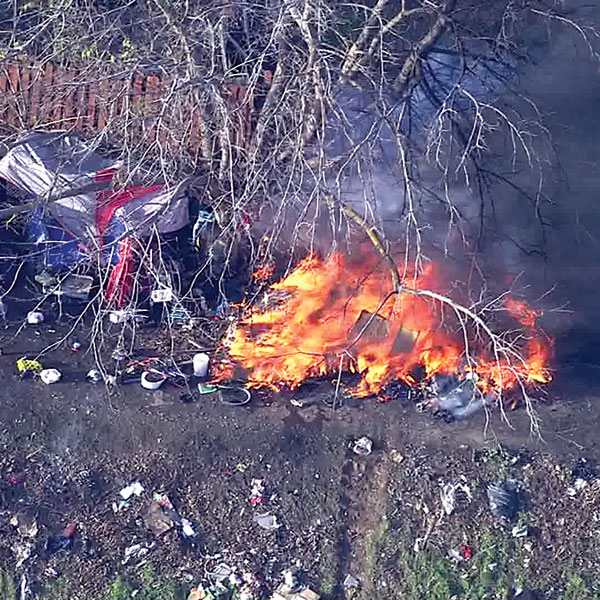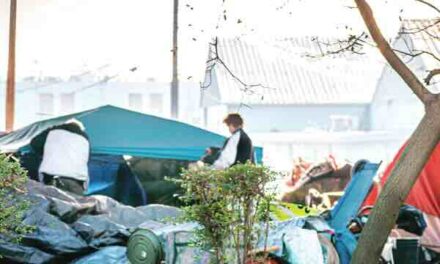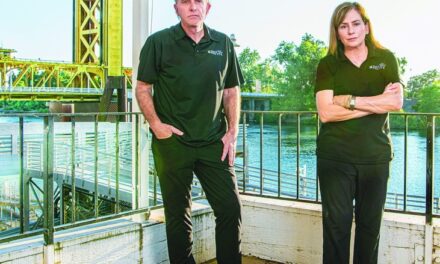While massive wildfires in California make headlines, the increase in fires around homeless encampments doesn’t receive the same attention. Sacramento endures this alarming trend with other major cities, including Oakland, Los Angeles, San Francisco and San Jose.
Sacramento’s 2022 homeless count found 9,278 unsheltered people in the county. Despite massive taxpayer investments, the numbers continue to move in the wrong direction. The county had 5,570 homeless in 2019, and 2,538 in 2013.
During the past decade, encampment-related fires grew with the homeless population. An April 2022 report by the Sacramento Sierra Club notes the Sacramento Fire Department responded to 536 encampment fires between 2013 and 2019, an average of 89 a year. The report cited 156 encampment fires in 2021.

In addition to human suffering on our streets, urban fires around encampments and related drug activities harm residents, neighborhoods and parkways. Drought makes the problem even more destructive. Urban fires devour resources needed to fight massive wildfires.
There are several reasons behind the dangerous trend of encampment fires. Open flames provide heat for people living in streets and parks, and give light at night. But a candle can spark a fire. With no fire extinguishers nearby, flames quickly spread.
Investigators report fire attacks at encampments often stem from disputes between homeless people. The sheer number of fires, and the danger of attacks from outsiders, have unnerved firefighters, investigators and communities.
Open-air drug users need fire to light pipes of deadly fentanyl and meth. Being in a drug-induced stupor impairs judgment and impacts the safety of anyone nearby.
Encampments accumulate trash, which becomes fire fuel. There are reports of individuals even setting fire to their possessions because nonprofit homeless providers issue new equipment and cash payments.
Crime contributes to fire risk. Thieves steal cars and torch them, often using guns to ignite gas tanks. Burned-out cars are a sad, common sight on our streets. Arson for its own sake is a reality.
Urban fires destroy trees and natural vegetation, infrastructure, and commercial and residential buildings. They cause injuries and claim the lives of humans and animals.
And urban fires touch people miles from the blaze. Smoke and pollutants reduce air quality. A recent vehicle fire near E Street in Midtown produced smoke and odor that traveled miles. Online air-quality maps show in vivid detail the damage from fire.
Last year, a three-story medical building on Scripps Drive was torched. It appears the fire started in encampments beneath the building’s eaves, hidden behind bushes.
While I was writing this column, I received notification from the Sacramento Metropolitan Fire District saying firefighters responded to a 2-acre vegetation fire along the American River Parkway. Illegal encampments are common in the area.
Downtown and Midtown are heavily impacted by urban fires. On May 5, an early morning fire was reported along a fence near the rear of a home in the 2700 block of T Street. The fire engulfed the fence and burned the home’s deck.
Sacramento fire officials said the house began to burn, but crews tackled the flames and prevented extensive damage.
Power lines nearby were affected. The fire’s cause has not been established, but a family member of mine lives in the area and says transients are always present and property destruction is common.
As for fire investigations, local agencies have limited resources and expanded caseloads. Even if they determine an exact cause, it usually doesn’t provide satisfaction for the victims. Criminal charges only occur when there are competent witnesses.
When we built a new home last year, we were required to install an expensive fire-suppression system. I hope we never need it. Residential and commercial fires are devastating.
Before researching this article, I never thought much about the fire risk our community faces from encampments, open-air drug use and criminal activity. You cannot miss seeing the depressing charred remains after a fire. Added to the tons of trash on our streets, parks and vacant lots, parts of our city look more like a third-world country than California’s capital.
This becomes one more reason why we need strong leadership to usher in new approaches and proven strategies to bring people off the streets and into shelter, and to start putting their lives together with rehabilitation programs. Housing alone will never solve this crisis.
Cecily Hastings can be reached at publisher@insidepublications.com. Follow us on Facebook and Instagram: @insidesacramento.


















